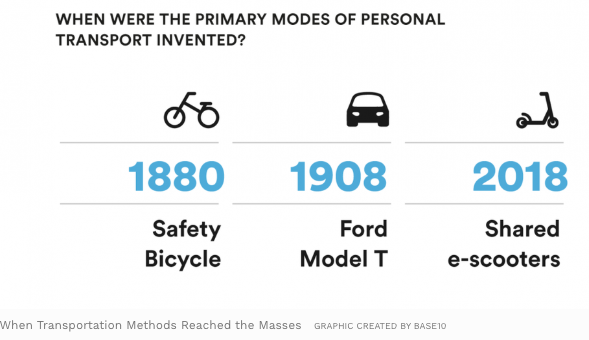A phenomenon called micromobility −which refers to short-distance transport− emerges as a powerful alternative to the current transit mix.
Existing transportation can no longer support the rising congestion in cities worldwide.
Despite that the annual scorecard by INRIX saw Istanbul, Bogota, Mexico City and Sao Paulo become the top 5 most congested cities worldwide during 2018, congestion is also rapidly rising in other big metropolis like New York, Los Angeles, London and Paris, meaning there is no escape from dense urban mobility, it needs to be fixed.
One of the strongest actions toward a better mobility is micromobility, which refers to short-distance transport, usually less than 5 miles, and has already started heavily competing in the market, as bike and scooter-sharing companies are convinced to remake the current urban landscape.
Why micromobility?
[ihc-hide-content ihc_mb_type=”show” ihc_mb_who=”3,4,5,6″ ihc_mb_template=”3″ ]
Projections show that by 2050, an additional 2.5B people will reside in urban areas globally, and if today is tough, let’s imagine over 25 years from now, especially when transport congestion carries health consequences in the form of accidents and air pollution.
According to McKinsey, roughly 60% of all trips in the U.S. are 5 miles or less, so the market is set to enjoy an expected net worth of over $200B by 2030. Plus, across the world, investors have already poured more than $5.7B into micromobility startups during the past 4 years after seeing the global potential it has for massively disrupting the mobility industry.
With most cities already dealing with dangerous levels of pollution and gridlocked streets, micromobility could equally help to reduce the amount of cars on the road, lowering our environmental footprint and increasing access to public transportation — all while being cost effective.
The current status
The micromobility revolution is in full swing.
As about 70% of Americans living in major urban areas view e-scooters positively, according to a 2018 survey, several U.S.-based scooter-sharing companies have already reached unicorn status at lightning speeds.
Shared bike usage in the U.S. shot up 25% between 2016 and 2017 alone, and the number of shared bikes in the country more than doubled in the same period to around 100,000 bikes with the majority of those new bikes being dockless.
However, negative headlines about e-scooters have also emerged, as they end up in lakes and oceans, congest sidewalks and house entries, turn out stolen, cause injuries and transit accidents.
Intense competition have tempered the narrative and suggest e-scooters are not the best micro-mobility option after all, but it actually depends on who you ask.


By region
According to CB Insights, North America’s largest ride-hailing companies like Uber and Lyft have recently joined the micromobility revolution aiming t to incorporate all forms of transportation into their portfolio of services. Currently, over 30% of micromobility riders in the region have reported using e-scooters to replace car rides on their most recent trip, signaling the positive impact micro-mobility solutions can have on reducing congestion.
Across the rest of the world, the trend hasn’t really exploded in South America, but the region is working on developing its presence, most notably in Sao Paulo, Brazil — South America’s largest city, however, startups focusing on e-scooters could see more success within the region.
In Europe, micromobility is not a new concept throughout Europe, in fact, European cities were some of the first to offer shared bicycles as a public service. It is now a market expected to grow at an annual growth rate of 5.5% until 2022.
In Africa, it’s yet to take off, as there is very limited infrastructure in place to support bicycles and scooters in most of Africa’s cities. Just in 2016, Marrakech, Morocco was the first city in Africa to launch a citywide bike-sharing program.
[/ihc-hide-content]














